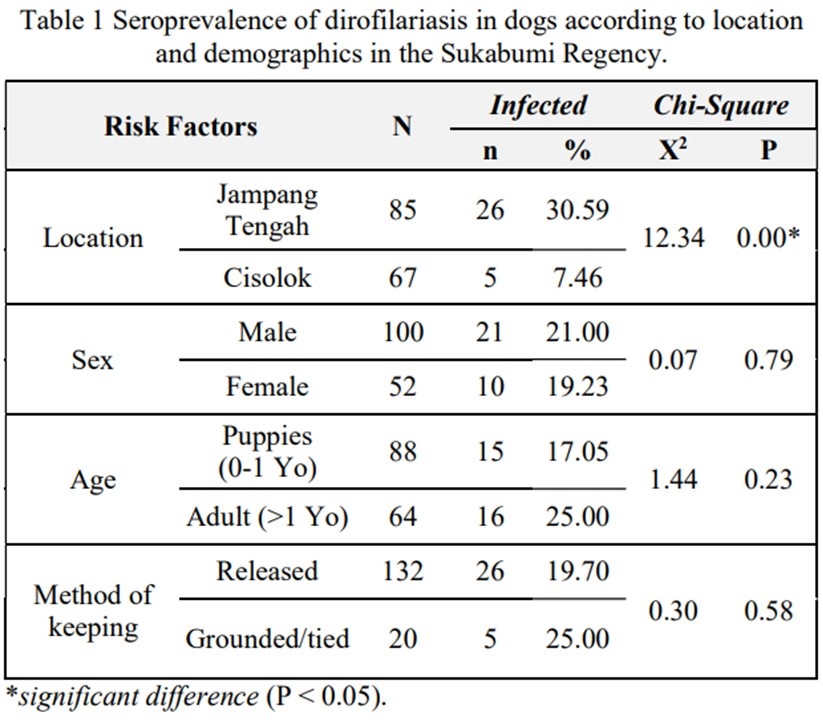Seroprevalence of dirofilariasis in dogs in Sukabumi Regency
Abstract
Dirofilariasis is a serious zoonotic disease in dogs. This study aimed to measure the prevalence and determine the risk factors of dirofilariasis in the Sukabumi Regency. A total of 152 blood samples were collected from dogs in two sub-districts in Sukabumi which have different topographic characteristics, namely Jampang Tengan District which is a hilly area, and Cisolok District which is a coastal area. Blood serum was examined using the commercial rapid test kit CHW Ag Test Kit 2.0 ® Bionote to detect the presence of the Dirofilaria immitis adult worm antigen. The results showed that the seroprevalence of dirofilariasis in dogs in the Sukabumi Regency was 20.4%. Areas with hilly characteristics have a higher prevalence of dirofilariasis than coastal areas do. The incidence of dirofilariasis in the Sukabumi Regency was not influenced by sex, method of keeping, or age of the dog.
Downloads
References
Anvari A, Saadati D, Siyadatpanah A, Gholami S. 2019. Preva-lence of dirofilariasis in shepherd and stray dogs in Iran Shahr, Southeast of Iran. Journal of Parasit Diseases. 43(2): 319-323. https://doi.org/10.1007/s12639-019-01096-5 | PMid:31263340 PMCid:PMC6570724
Andiarsa D, Hairani B, Fadilly A. 2018. Brugia malayi dan Dirofilaria spp sebagai penyebab filariasis pada hewan reservoir di daerah endemis di Kalimantan. JHECDs: Journal of Health Epidemiology and Communicable Diseases 4(1): 24-30. https://doi.org/10.22435/jhecds.v4i1.367
Assady M, Nazaruddin, Dwinna A, Hamdani, S Aisyah, Rosmaidar. 2016. Prevalensi dirofilariasis pada anjing lokal (Canis domestica) di Kecamatan Lhoknga Aceh Besar secara patologi anatomis. Jurnal Medika Veterinaria. 10(2): 109-111. https://doi.org/10.21157/j.med.vet..v10i2.4634
Boonyapakorn C, Srikitjakarn L, Morakote N, Hoerchner F. 2008. The epidemiology of Dirofilaria immitis infection in out-patient dogs at Chiang Mai University Small Animal Hospital, Thailand. Southeast Asian Journal Tropical Medicine and Public Health. 39(1): 33-38.
Erawan IGM, Tjahajati I, Nurcahyo W, Asmara W. 2017. Preva-lence and risk factor of the Dirofilaria immitis infection in dogs slaughtered in Daerah Istimewa Yogyakarta. Jurnal Veteriner. 18(4): 541-546. https://doi.org/10.19087/jveteriner.2017.18.4.541
Hoch H, Strickland K. 2008. Canine and Feline Dirofilariasis: life cycle, pathophysiology, and Diagnosis. Compendium. 30(3): 133-140.
Jalali MR, Alborzi A, Avizeh R, Mosallanejad B. 2010. A study on Dirofilaria immitis in healthy urban dogs from Ahvaz, Iranian Journal of Veterinary Research. 11(4): 357-362.
Satrija F, Ridwan Y, Wulandari N, Ming Y. 2008. Prevalensi dan faktor risiko infeksi cacing jantung (Dirofilaria immitis) pada anjing peliharaan di Jawa dan Bali. Procedings of KIVNAS. Bogor, Indonesia, August 19th-22nd 2008.
Vieira AL, Vieira MJ, Oliveira JM, Simoes AR, Diez-Banos P, Gestal J 2014. Prevalence of canine heartworm (Dirofilaria immitis) disease in dogs of central Portugal. Parasite. 21(5): 1-7. https://doi.org/10.1051/parasite/2014003 | PMid:24534524 PMCid:PMC3927308
Yildirim A, Ica A, Atalay O, Duzlu O, Inci A. 2007. Prevalence and epidemiological aspects of Dirofilaria immitis from Kayseri Province, Turkey. Research in Veterinary Science. 82(3): 358-363. https://doi.org/10.1016/j.rvsc.2006.08.006 | PMid:17064741

Copyright (c) 2023 CC-BY-SA

This work is licensed under a Creative Commons Attribution-ShareAlike 4.0 International License.
Authors who publish with this journal agree to the following terms:
1. Authors retain copyright and grant the journal right of first publication with the work simultaneously licensed under a Creative Commons Attribution License that allows others to share the work with an acknowledgement of the work's authorship and initial publication in this journal.
2. Authors are able to enter into separate, additional contractual arrangements for the non-exclusive distribution of the journal's published version of the work (e.g., post it to an institutional repository or publish it in a book), with an acknowledgement of its initial publication in this journal.
3. Authors are permitted and encouraged to post their work online (e.g., in institutional repositories or on their website) prior to and during the submission process, as it can lead to productive exchanges, as well as earlier and greater citation of published work (See The Effect of Open Access).

.jpg)















